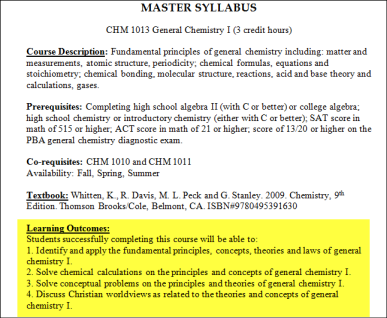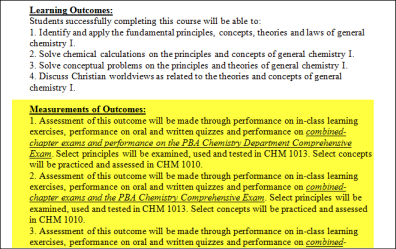

How to modify a Master Syllabus to create your DEP Syllabus
How to post your approved DEP syllabus in your eCollege course shell
Note: The Master Syllabus for your course will be provided for you in Doc Sharing. It is hidden from the students. This document is a resource for the professor and is not the student syllabus; it should remain hidden for the professor access only.




The PBA course title and course code must be included within your DEP syllabus.

This information will be in the Master Syllabus located in Doc Sharing of the course.
CHM 1013 General Chemistry I (3 credit hours)


The PBA catalog description in the course's Master Syllabus must be included in your DEP syllabus as it appears in the Master Syllabus.
Course Description: Fundamental principles of general chemistry including: matter and measurements, atomic structure, periodicity; chemical formulas, equations and stoichiometry; chemical bonding, molecular structure, reactions, acid and base theory and calculations, gases.
Prerequisites: Completing high school algebra II (with C or better) or college algebra; high school chemistry or introductory chemistry (either with C or better); SAT score in math of 515 or higher; ACT score in math of 21 or higher; score of 13/20 or higher on the PBA general chemistry diagnostic exam.
Co-requisites: CHM 1010 and CHM 1011


The PBA required textbook(s) must be included within the syllabus.
Note: The textbook may be updated each year, please be sure to take textbook information from the provided Master Syllabus rather than your syllabus from a prior year.
Textbook: Whitten, K., R. Davis, M. L. Peck and G. Stanley. 2009. Chemistry, 9th Edition. Thomson Brooks/Cole, Belmont, CA. ISBN#9780495391630


The PBA Student Learning Outcomes from the Master Syllabus must be included within your DEP syllabus.
Note: Additional outcomes may be added; however none may be deleted.
Learning Outcomes:
Students successfully completing this course will be able to:
1. Identify and apply the fundamental principles, concepts, theories and laws of general chemistry I.
2. Solve chemical calculations on the principles and concepts of general chemistry I.
3. Solve conceptual problems on the principles and theories of general chemistry I.
4. Discuss Christian worldviews as related to the theories and concepts of general chemistry I.


The PBA Measurement of Student Learning Outcomes must be included within the syllabus.
Note: You may add customized measurements of your own; however, the Common Assessment Assignment should be included.
Measurements of Outcomes:
1. Assessment of this outcome will be made through performance on in-class learning exercises, performance on oral and written quizzes and performance on combined-chapter exams and performance on the PBA Chemistry Department Comprehensive Exam. Select principles will be examined, used and tested in CHM 1013. Select concepts will be practiced and assessed in CHM 1010.
●
2. Assessment of this outcome will be made through performance on in-class learning exercises, performance on oral and written quizzes and performance on combined-chapter exams and the PBA Chemistry Comprehensive Exam. Select principles will be examined, used and tested in CHM 1013. Select concepts will be practiced and assessed in CHM 1010.
3. Assessment of this outcome will be made through performance on in-class learning exercises, performance on oral and written quizzes and performance on combined-chapter exams and performance on the PBA Chemistry Department Comprehensive Exam. Select principles will be examined, used and tested in CHM 1013. Select concepts will be practiced and assessed in CHM 1010.
4. Assessment of outcome #4 will be made through evaluating written assignments, classroom presentations and development of the topic selected.

All DEP courses include a Common Assessment Assignment (CAA) which can be found in the Master Syllabus.
All student-submitted Common Assessment Assignments will be archived in the eCollege course shell.
Note: The CAA is a requirement. College credit may not be awarded to students who do not submit the CAA.
The CAA may be in one of the following formats:

You should create your own course outline. A Course Outline may be available as a guide in the Master Syllabus for your course; however, you are not required to model the one in the Master Syllabus.
It should include:
Course Outline:
I. Matter and energy, measurements, dimensional analysis, density and heat. Quiz 1.
II. Chemical formulas, the mole, formula weights, determining molecular formulas. Quiz 2.
III. Chemical equations, calculations based on chemical equations, concentrations of solutions. Quiz 3.
Exam I.
IV. Introduction to periodic law, oxidation/reduction, classifying chemical reactions. Quiz 4.
V. Atomic theory, electron configuration. Quiz 5.
VI. Chemical periodicity. Quiz 6.
Exam II.
VII. Ionic and covalent bonding, Lewis formula, resonance, polar and nonpolar bonds. Quiz 7.
VIII. Valence shell electron pair repulsion theory, valence bond theory, molecular shapes and bonding. Quiz 8.
IX. Molecular orbitals. Quiz 9.
Exam III.
X. Acids, bases and salts. Quiz 10.
XI. Calculations in acid/base and oxidation/reduction solutions. Quiz 11.
XII. Gases and the kinetic molecular theory. Quiz 12.
Exam IV: The PBA Chemistry Department Comprehensive Exam (CCA for this course).
